Review of Eugene Aram
The atmosphere in St. Cuthbert‘s Church Pateley Bridge was lively, bustling and expectant. People were milling around, greeting friends and acquaintances as if they had not seen them for many months. They were selecting chairs at the front of the church when normally they would sit as far back as possible! The altar had gone and in its place was a large open area. The people purposefully congregating in this space were dressed in basic attractive black and white attire from three hundred years ago.
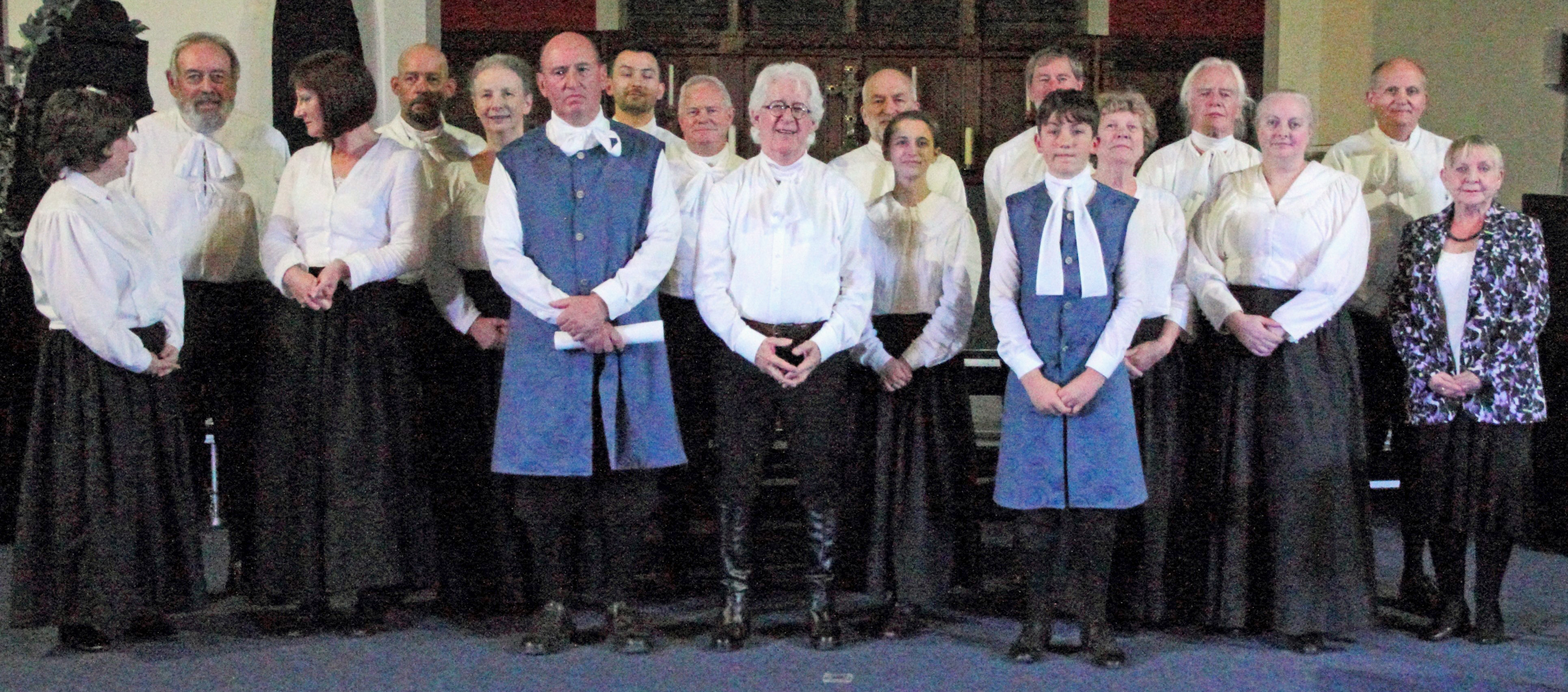
The Cast
What was happening?
We were awaiting Nevin Ward’s new play, ‘ The Life of the celebrated Eugene Aram of Ramsgill in Netherdale’, to be presented in St. Cuthbert’s Church rather than the Playhouse, where ongoing alterations precluded productions in the Pateley Bridge Dramatic Society’s home. Nevin’s reputation has gone before him; we remembered his previous history plays: ‘The Dam Play’ and ‘Gouthwaite Hall’ as well as ‘The Wind in the Willows’, ‘A Christmas Carol” and the Mediaeval Mystery plays of 2000. I have my own memories of the help he gave me by providing the music for the 1977 pageant we produced at Burnt Yates School. We all knew that we were in safe hands and that the evening ahead of us would be filled with imaginative staging, lively music and excellent acting as we heard of Eugene Aram’s birth in Ramsgill in 1704, his early life and unusual education, and the events which led him to be tried at York Assizes before his execution on the Knavesmire for the murder of Daniel Clark at Knaresborough.
The clever and attractive programme, like the advance publicity material, led us to expect a complicated story from the eighteenth century, a cast of 43 characters and a total of 18 actors and musicians of the highest calibre. In his Director’s Notes Nevin alluded to the long and complex journey that he had to take to bring this play to us; if you Google ‘Eugene Aram’ yourself you will find a plethora of information, which Nevin sorted and interpreted for our entertainment. He is a very skilful playwright and has given us a treat; his team of actors, musicians and technical staff have served him well.
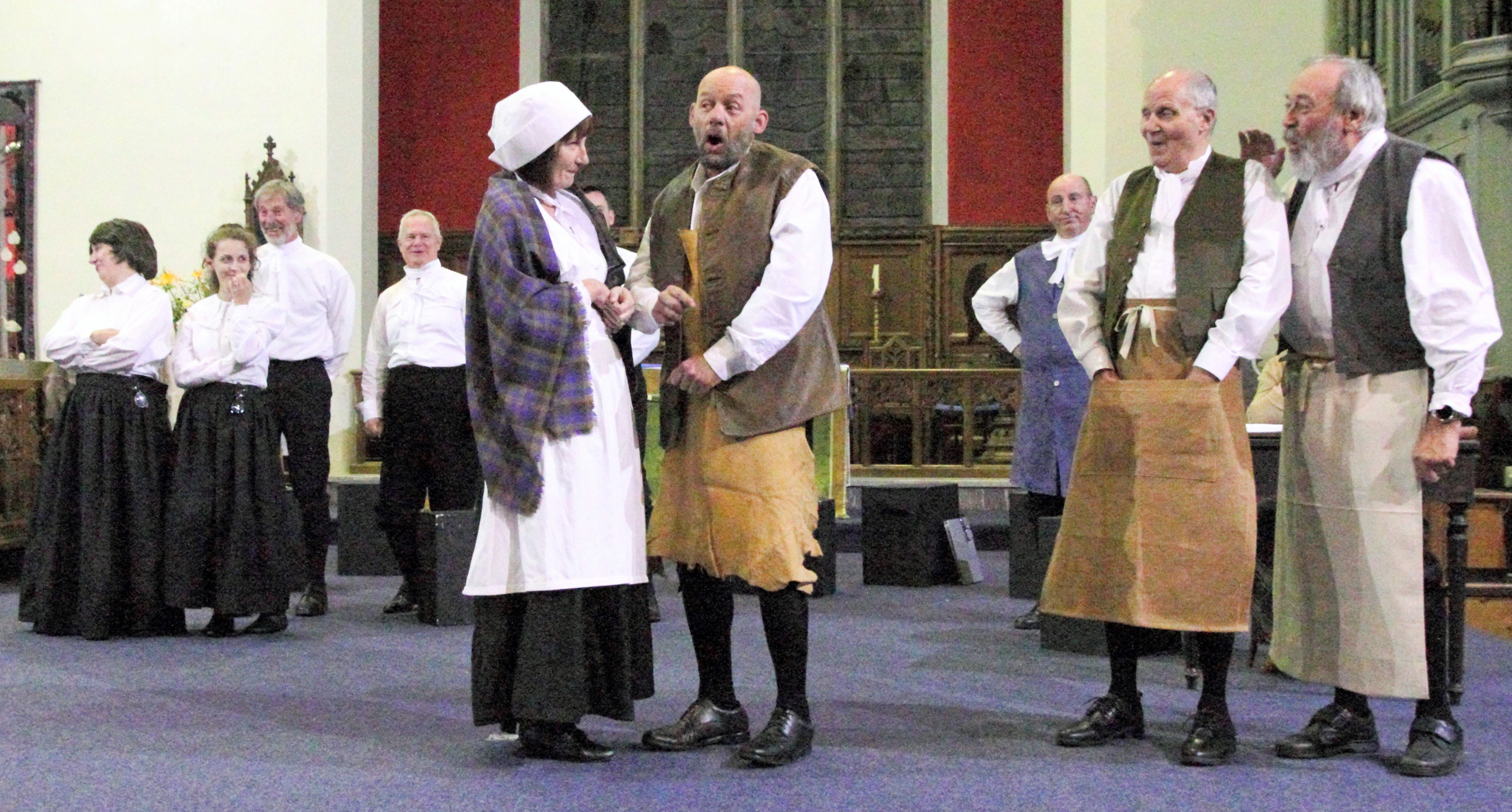
As the play developed we realised that the 18 players were going to be visible all the way through but at no time did the changing of costume or set furniture intrude; all was completed efficiently and unobtrusively. By adding a small item such as a hat or bonnet, an apron or a jacket, a whole new character was achieved. The wardrobe department must be praised for their planning and ingenuity. The set had been cleverly constructed in such a way that the minimal changes of scenery occurred without the audience really being aware. Well done, Justin Enthoven and team!
The music was, as always in Nevin’s plays, a strong backbone of the production. Carol Bailey’s skilful playing of the bodhran gave a strong rhythm to many of the songs and supported Nevin (guitar and slide guitar), Steve Rouse (melodeon, e-melodeon, fiddle, harmonica), and Heather Appleton (fiddle) in their melodic playing. The acoustics of the church, while often causing difficulties for the speaking parts, uplifted and enhanced the lively singing. The choreography of the songs was slick and most effective.

Musicians Steve Rouse, Carol Bailey and Nevin Ward
With 43 characters and 18 actors there was much doubling up of roles, with stalwarts of the Playhouse very ably taking on two or three parts each and one relative newcomer, Alan Young, showing us four characters; each part was very different from the other three, delivered with clarity and four different accents. We believed in each of his strong characterisations.
In contrast, the eponymous hero, Eugene Aram, was played in turn by three very different actors, each passing the role to his successor by the touch of a hand. Very subtle but effective.
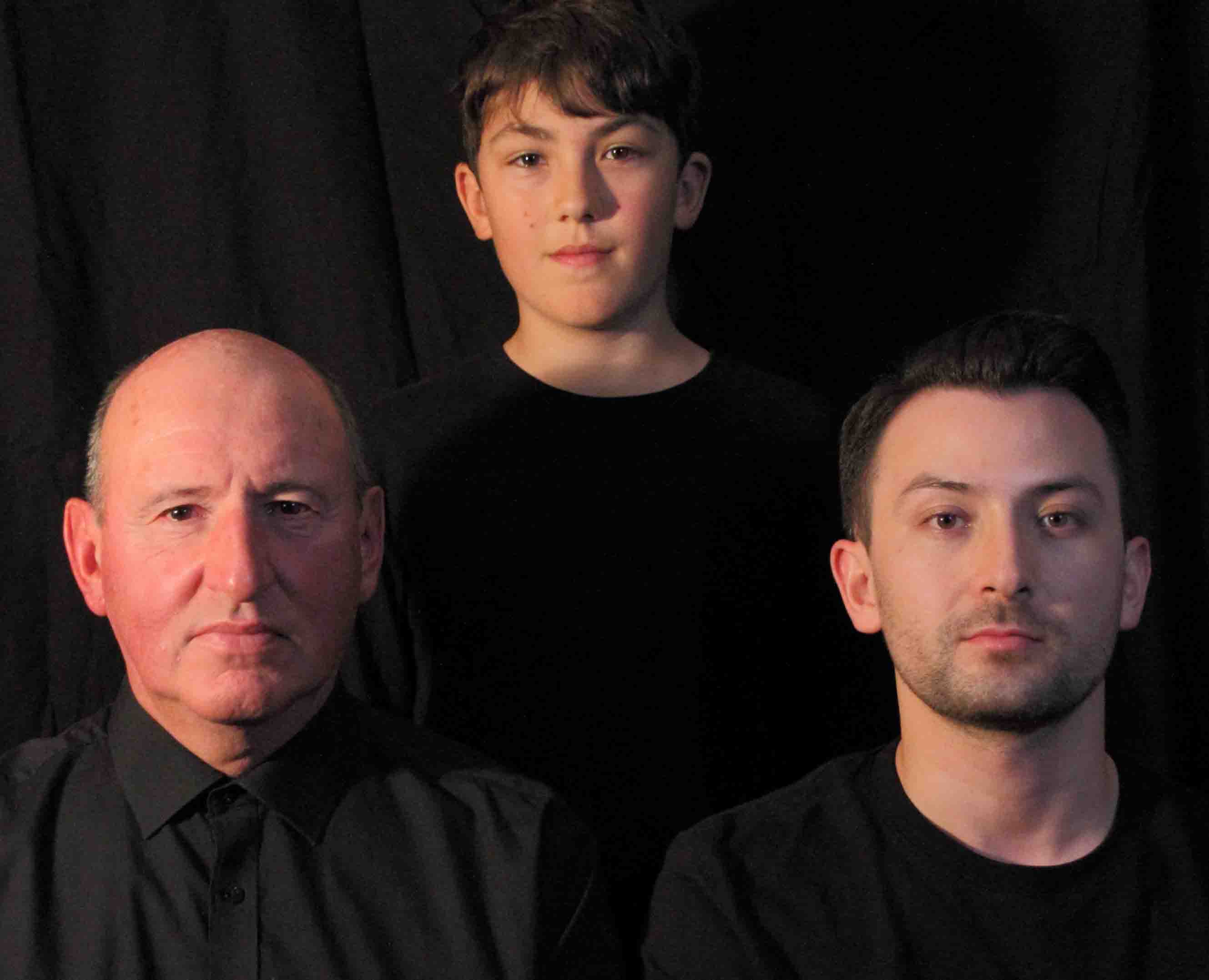
The Three Arams; Max Whiteley, Tim Wilkinson and Ben Derrick
Christine Ward as narrator welcomed us to the ‘interesting times’ in which we found ourselves and with the help of ‘Eugene Aram’ himself (Tim Wilkinson), took us back to the Barrel Inn, Knaresborough in 1740.

Christine Ward as the Narrator

Tim Wilkinson as Eugene Aram the Senior
In no time we were treated to the first of the excellent songs that we had grown to expect in Nevin’s plays. Talented instrumentalists Steve Rouse, Heather Appleton, and Carol Bailey joined Nevin and the whole cast to sing a traditional song, ‘Fathom the Bowl’. The enthusiastic applause which followed showed that the audience were fully appreciative of another of Nevin Ward’s treats.
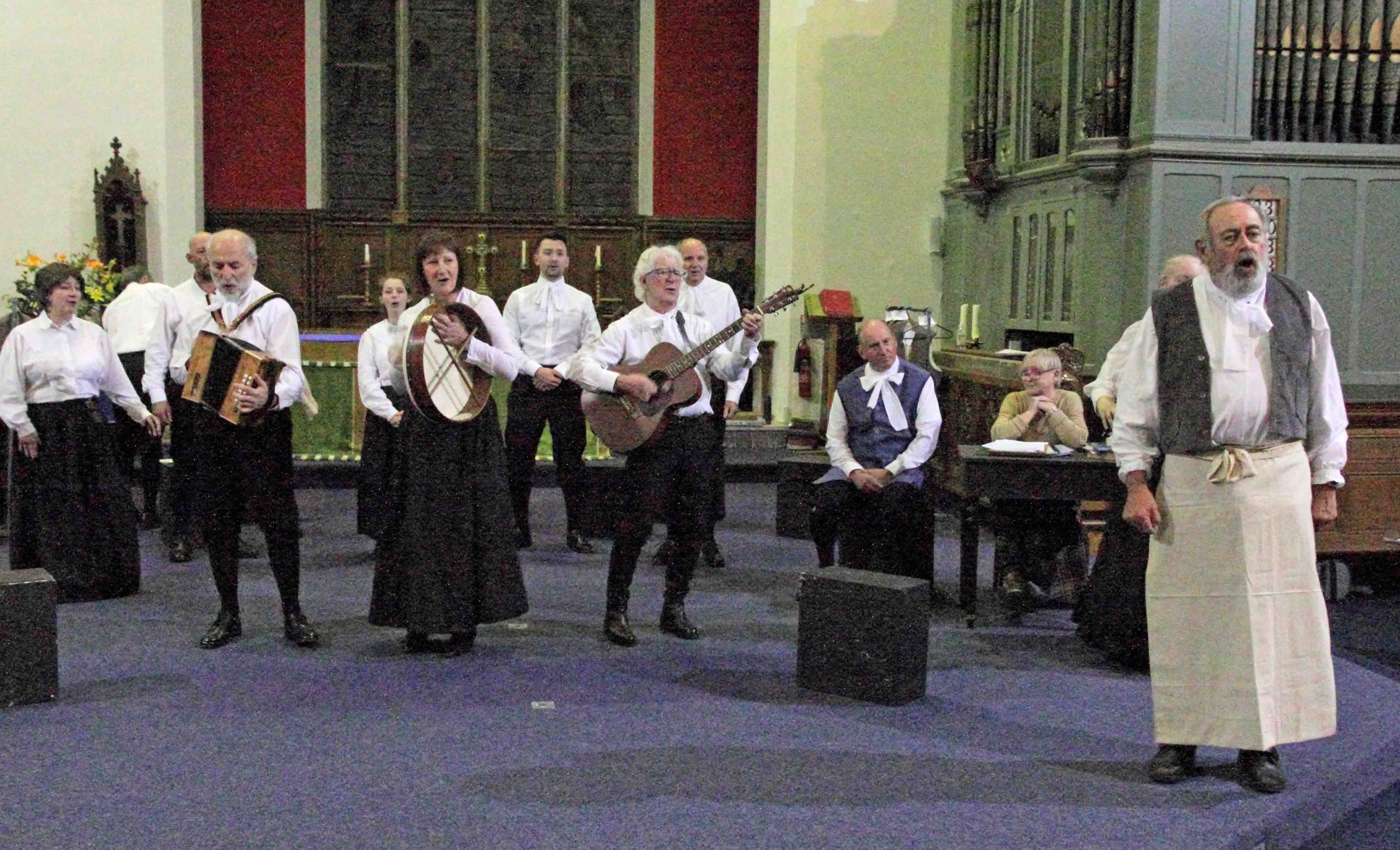
Fathom the Bowl
We were gradually informed and educated about life in the eighteenth century: the history, the politics and the justice system. We first met Peter Aram, Eugene’s father, a gardener of some standing, played boastfully by Keith Burton. His employers at Newby Hall were the Blacketts: Sir William Blackett, the patriarch, played with a confident and authentic North-East accent by Nevin Ward and his son Sir Edward Blackett played by Steve Rouse as a man full of his own importance.
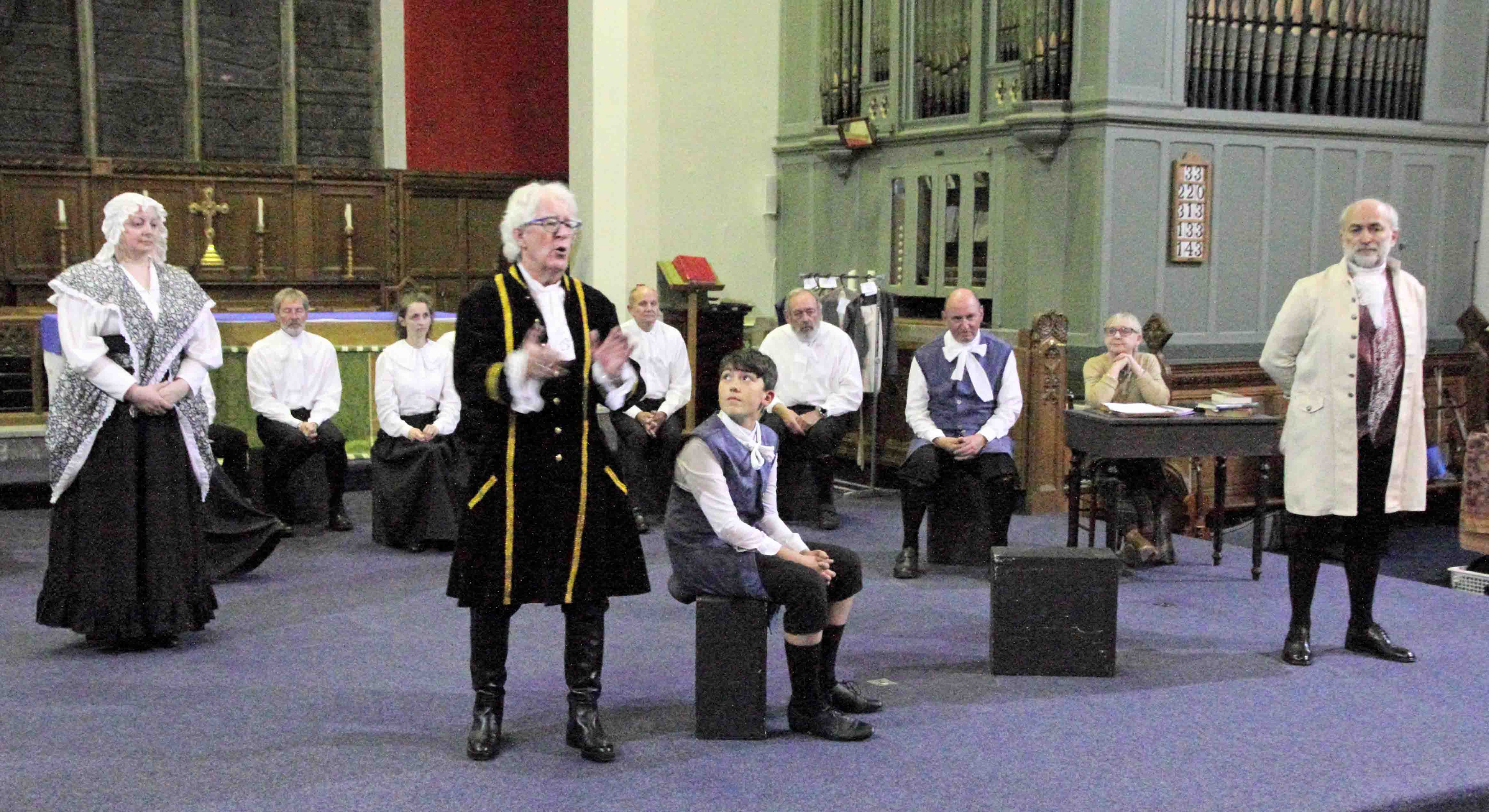
The Blackett Family
Poor Mary Blackett, Sir Edward’s wife, did not get much of a look in at first, but Heather Appleton came into her own when identified as the former Mary Yorke. She told us the story of the Yorke family and there was an allusion to the story of Gouthwaite Hall, dramatised by Nevin in 2009 and her love of the area of Netherdale, or Nidderdale. Her singing of ‘The view from Middlesmoor church’ was beautifully executed and very moving.

Heather Appleton as Mary Blackett
The first iteration of Eugene Aram, the young boy played by Max Whiteley, became a most effective foil for the Blackett men as they discussed their position in society and the politics of the time. Max, as boy Eugene, listened carefully, asked appropriate questions and followed the answers.

Max Whiteley as Eugene Aram the Younger
He soon handed over the role to Ben Derrick with the clasp of a hand and we moved on to the formative years of our hero.

Ben Derrick as Eugene Aram the Young Adult
We heard of Eugene’s education which began in the library of Newby Hall. His genius soon came apparent; he soaked up knowledge - algebra, calculus, philosophy, geography, history and especially languages. Mary Blackett’s family set up a school with Eugene as schoolmaster.
Ben Derrick played Eugene Aram as a serious, scholarly young man, but his coup de foudre moment when he met his future wife was high comedy. Brenna Watson played the younger version of Anna Spence, looking, as Aram himself said, “Lovely, radiant, beautiful”, but as she replied to his tentative advances, when she spoke, her raucous voice, her broad Yorkshire accent and her whole demeanour were so unexpected that the audience was thoroughly amused. When we heard the inept examples of wooing from her previous suitors, hilariously played by Peter Buller and Alan Young, we were in no doubt that marriage between Anna and Eugene was inevitable, in spite of the obvious mismatch.
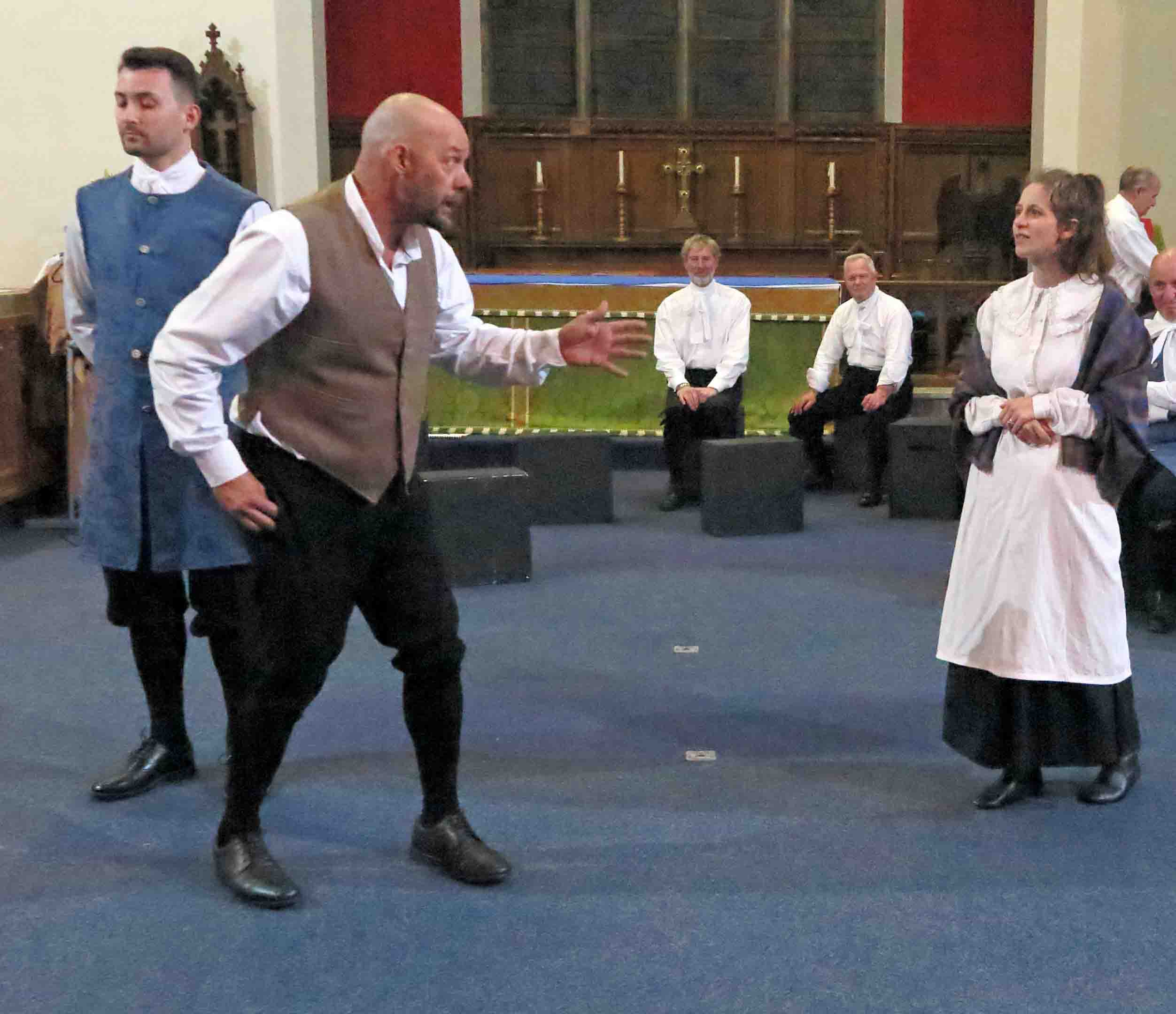
Alan Young as an unsuitable suitor with Brenna Watson as Anna Spence
Darryl Hall, typecast as the vicar, was in his element as the couple were married. The strong Welsh accent added to his considerable presence in the role and we, the audience enjoyed a chance to stand and sing the hymn.
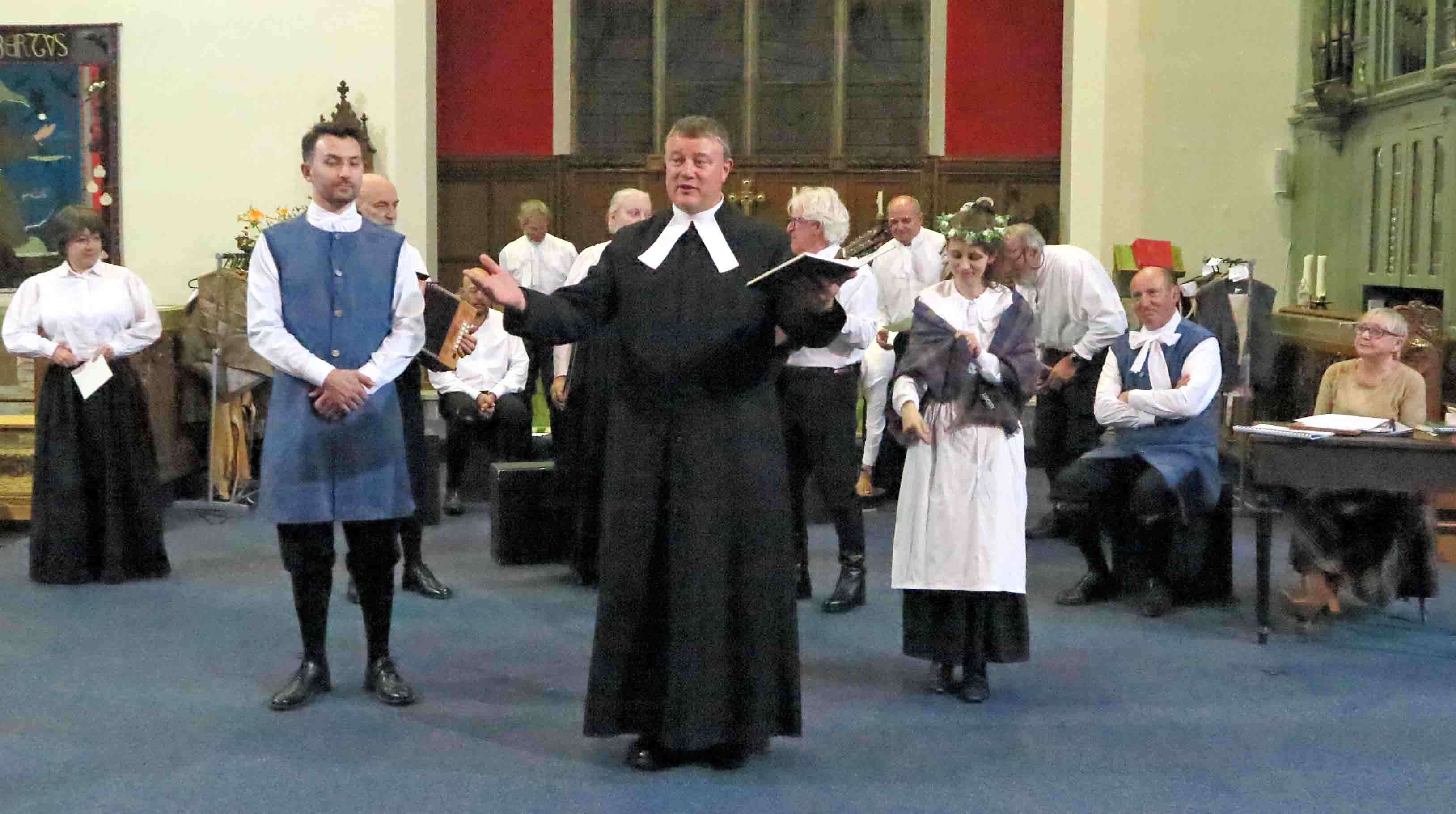
Darryl Hall as a Vicar
It was unfortunate but inevitable that the marriage failed, as both Anna and Eugene soon accused the other of changing. And we saw them change before our eyes! Carol Bailey replaced Brenna Watson and Tim Wilkinson replaced Ben Derrick.
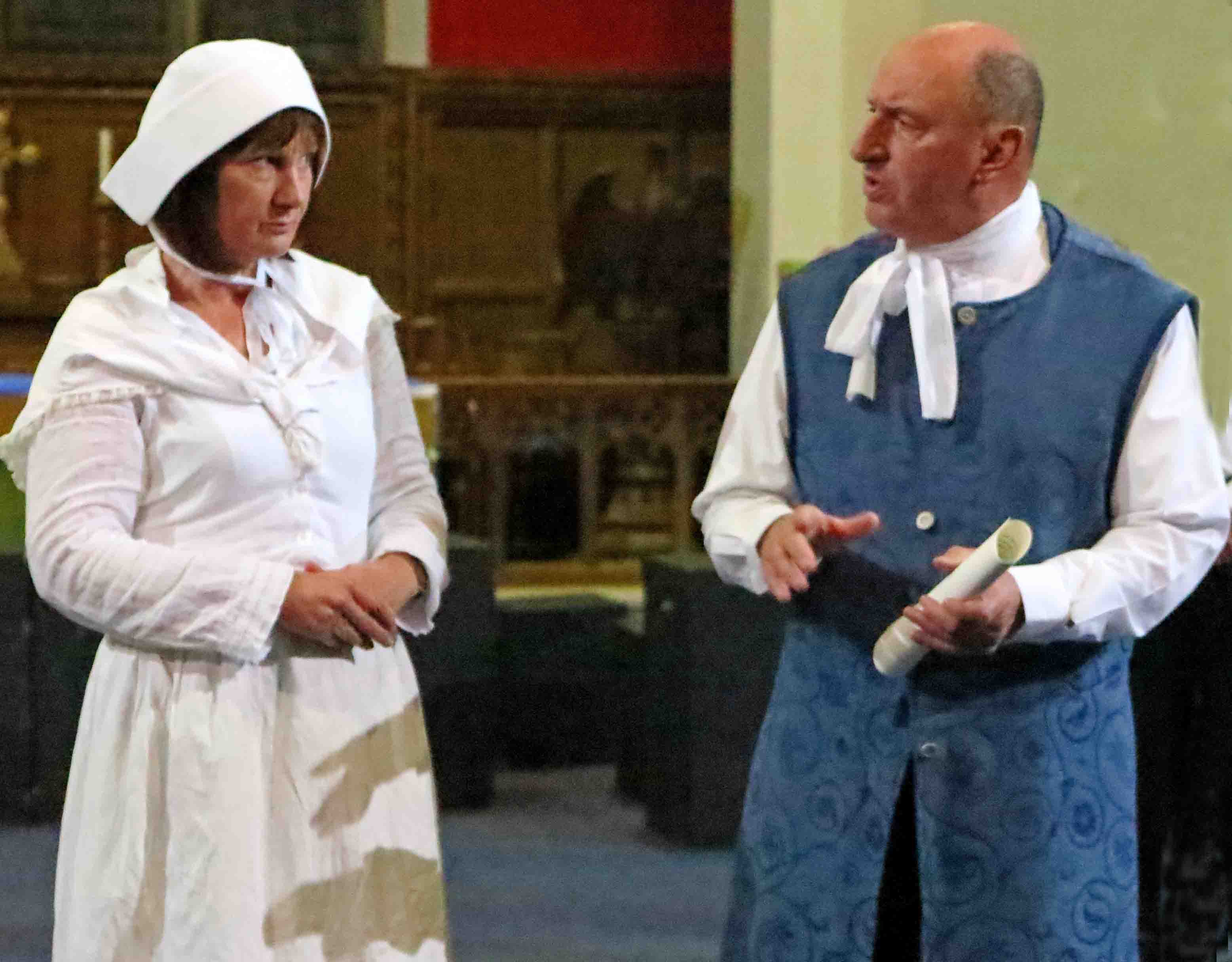
Carol Bailey as Anna Spence who becomes Mrs Eugene Aram
Anna, the agreeable companion became a nag and a scold, while Eugene immersed himself in his teaching, in his studying and in visits to the local pubs, so seemed to be never at home; Anna’s voice was something that didn’t change and it soon began to grate. Carol Bailey makes an excellent harridan and Tim Wilkinson fitted into the final iteration as into a glove. Aram was a genius with languages but his work as a schoolmaster was not a great success and a move to Knaresborough did not solve the problem. Mrs. Barbara Leetham, a local gossip, played with panache by Linda Harvey, began to tell us of the integration of Eugene Aram with the regulars at the Barrel Inn.

Linda Harvey as Barbara Leetham
He was much appreciated by the landlord, Henry Terry, and his wife, played with confidence and presence, by Jerry Harvey and Debbie Forsyth respectively. New characters were introduced: the flaxdresser, Richard Houseman (Peter Buller) who had a tendency to bore the other customers with his lectures on the process of flaxdressing, with its ‘swingling, rippling, and retting and heckling’, Daniel Clark the shoemaker, (a convincingly stuttering Alan Young) while Eugene Aram was much more in demand for his vast knowledge and business acumen.
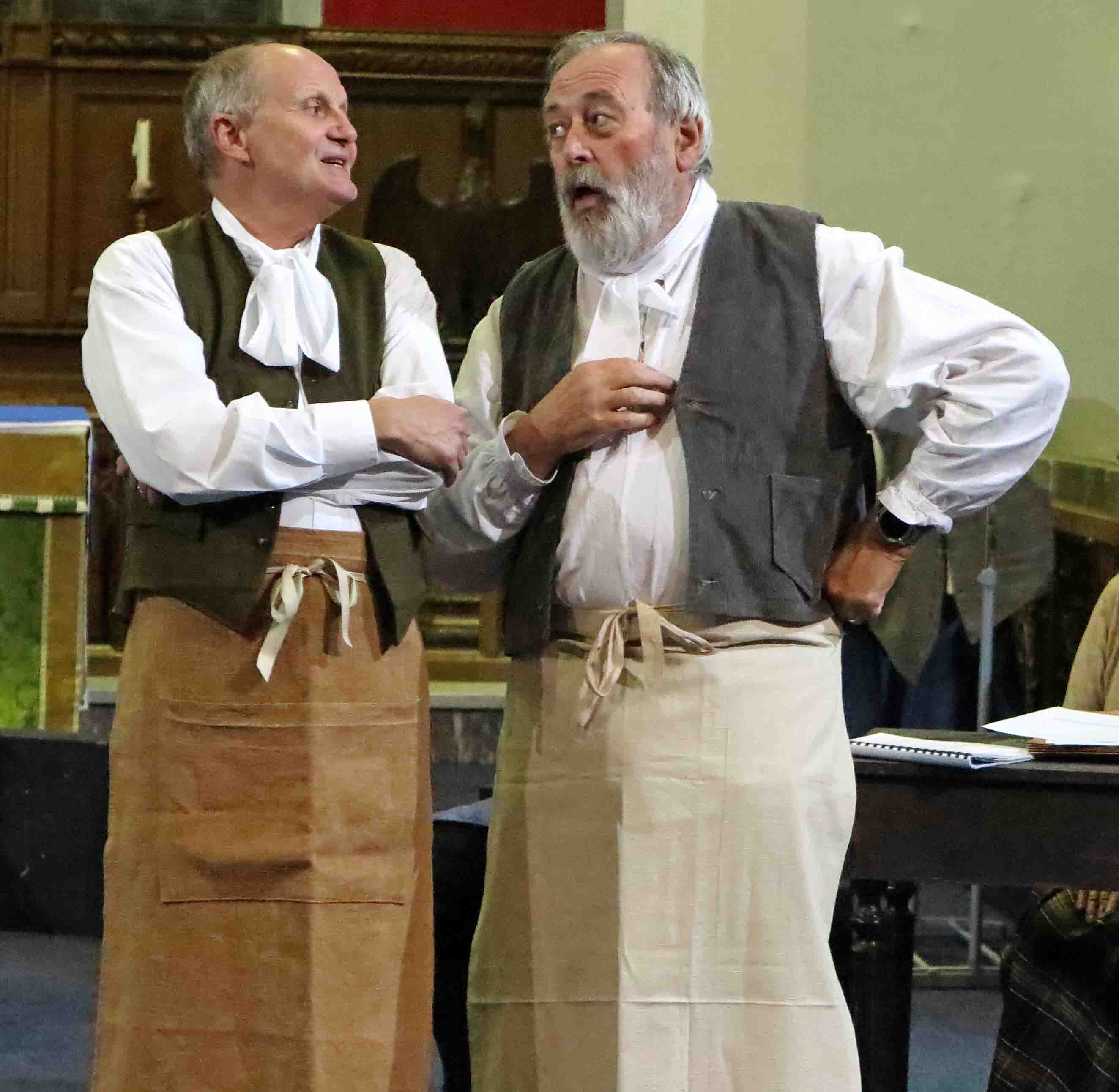
Peter Buller as Richard Houseman with Jerry Harvey as Henry Terry
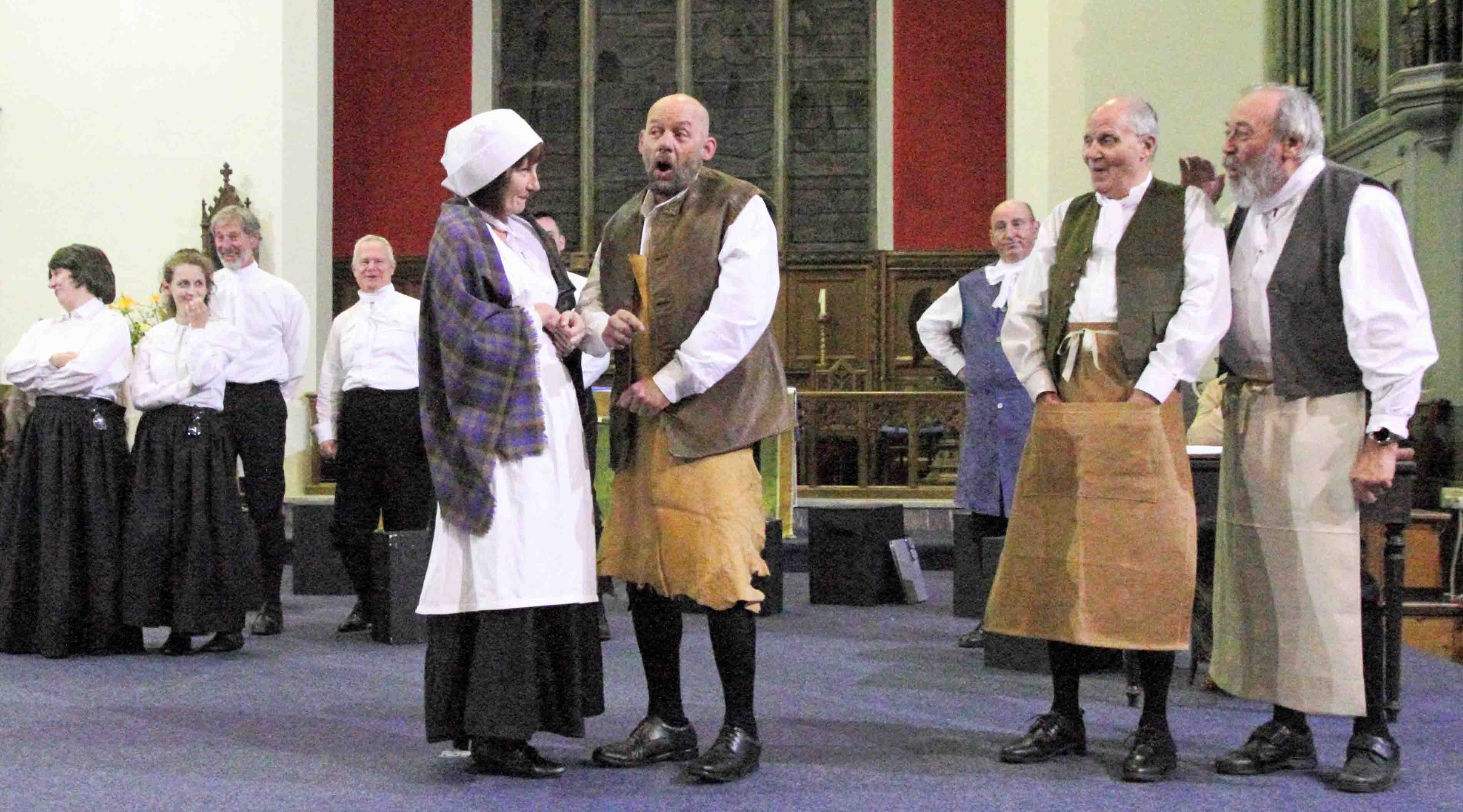
Alan Young as Daniel Clark liaises with Carol Bailey as Anna Aram
Good! Time for another song. The traditional song ‘The Prickle-Eye Bush’ which involved the whole company in clever choreography and wonderful singing seemed to presage the ending of the story. The full sound echoed round the building and was very moving.
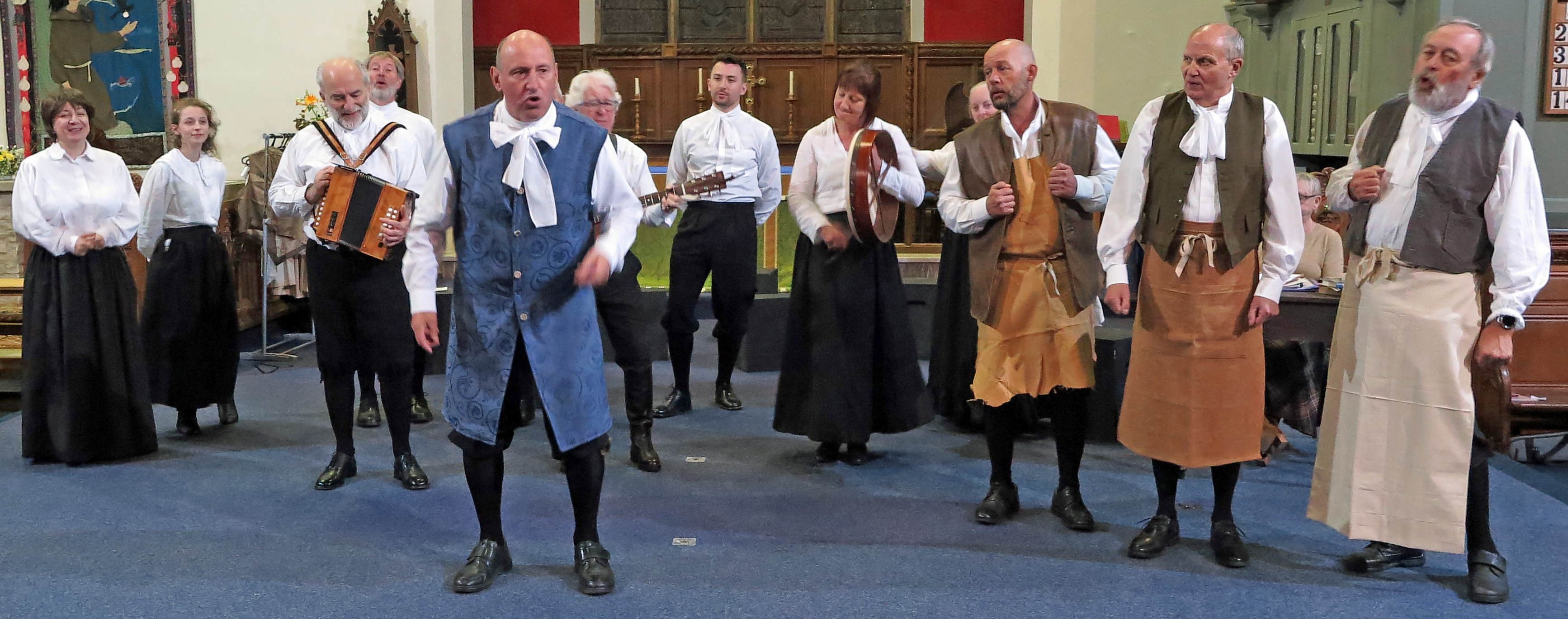
The Prickle Eye Bush
We heard how Daniel Clark was introduced, by Eugene Aram, to the idea of credit to solve his monetary problems. This solution ultimately led to the shock of his sudden disappearance. Mrs Terry and Barbara Leetham relished the telling of the tale, enjoying the spreading of rumour and innuendo. Daniel had completely vanished and no solution to the conundrum was found until, some 14 years later, bones were found in two different locations in Knaresborough.
Eugene Aram, had moved away from Yorkshire seeking success in his research, leaving his wife and family behind. Anachronisms and clever jokes abounded in the play, no more so than the appearance at this point of two delightful Jane Austen heroines (Brenna Watson and Heather Appleton again) who not only got their geographical location wrong (not Lyme Regis, but Lynn Regis) but also their chronological location with Jane Austin’s works being half a century away in the future.
Aram’s research into languages was bringing him acclaim and for further investigation he needed access to more prestigious libraries. It was in Lynn Regis, or as we know it King’s Lynn, a full thirteen years after the disappearance of Daniel Clark, that Eugene Aram was unexpectedly arrested for the murder of Daniel Clark. Rachel Joynson and Carol Bailey, the two cross-dressing constables, in their three cornered hats and huge overcoats manacled our hero and led him away as the lights faded for the end of Act One.
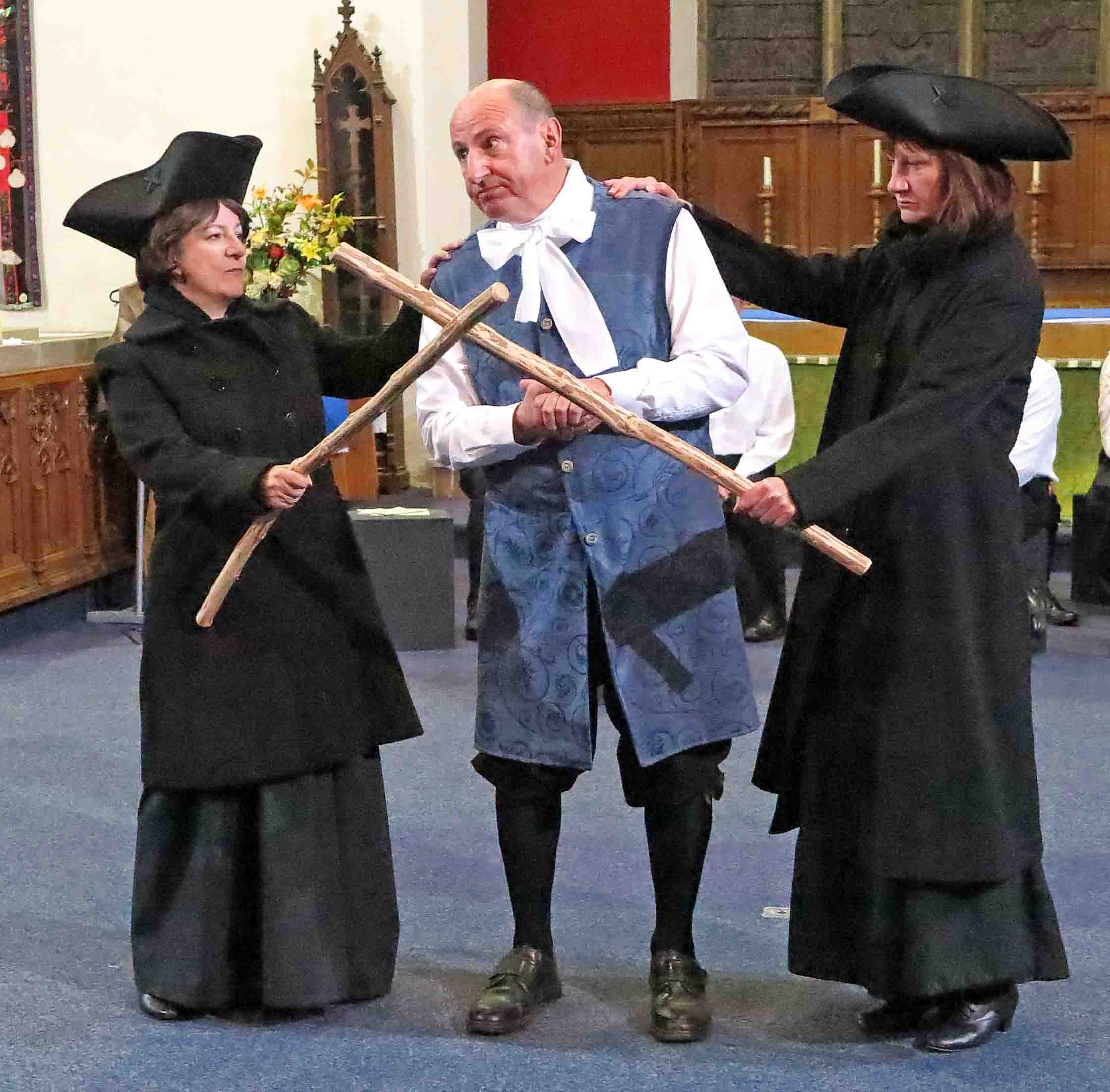
The Constables, Rachel Joynson and Carol Bailey arrest Eugene Aram
Act Two was somber and complicated but the audience remained rapt and engaged. In spite of beginning with arousing traditional Yorkshire words: ‘Ear all, See all, Say nowt’ cleverly adapted by Nevin, “to put us in the right frame of mind”, we had to concentrate hard as the action went back a year in time, to explain about the reasons for Eugene Aram’s arrest.
Jerry Harvey in his second role as John Theakston, the West Riding Coroner, and Michael Thorne as the Prosecutor opened up the inquest into the bones found at Thistle Hill.
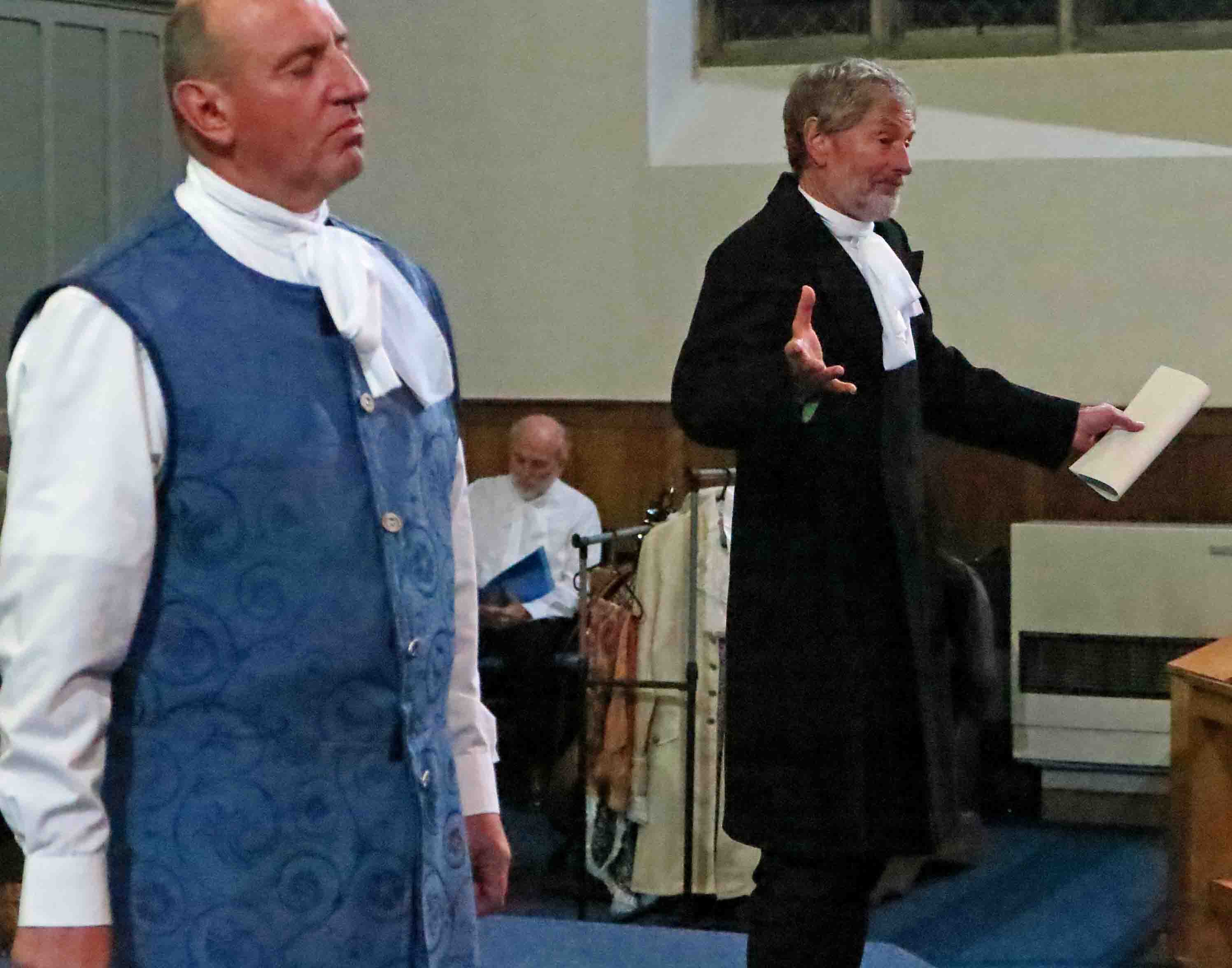
Michael Thorne prosecutes Eugene Aram
Their competent portrayals of these characters first gave us disquiet with the judicial system of the time. Alan Young’s chimney sweep, completely different from his previous roles, provided an entertaining cameo before being superseded by Linda Harvey as the garrulous Barbara Leetham. Their evidence was corroborated by two unconsciously entertaining surgeons cleverly played by Ben Derrick and Steve Rouse.
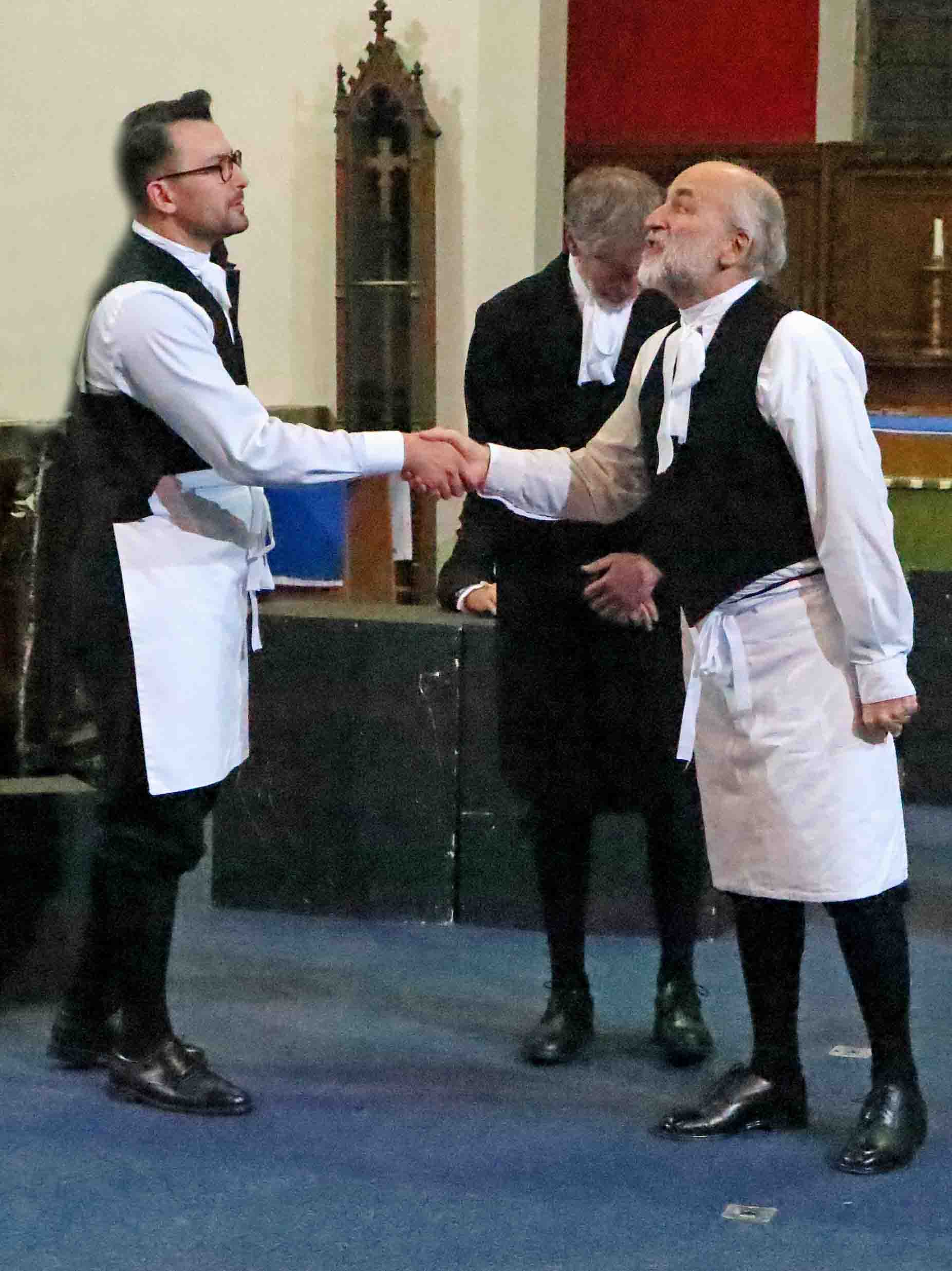
The two surgeons: Ben Derrick and Steve Rouse
When Eugene’s wife, Anna gave her testimony, her accusations were acted out by Aram, Clark and Houseman in a very imaginative conceit, showing the three characters wearing white masks in dimmed lighting and miming their actions before Daniel Clark disappeared. Most effective.
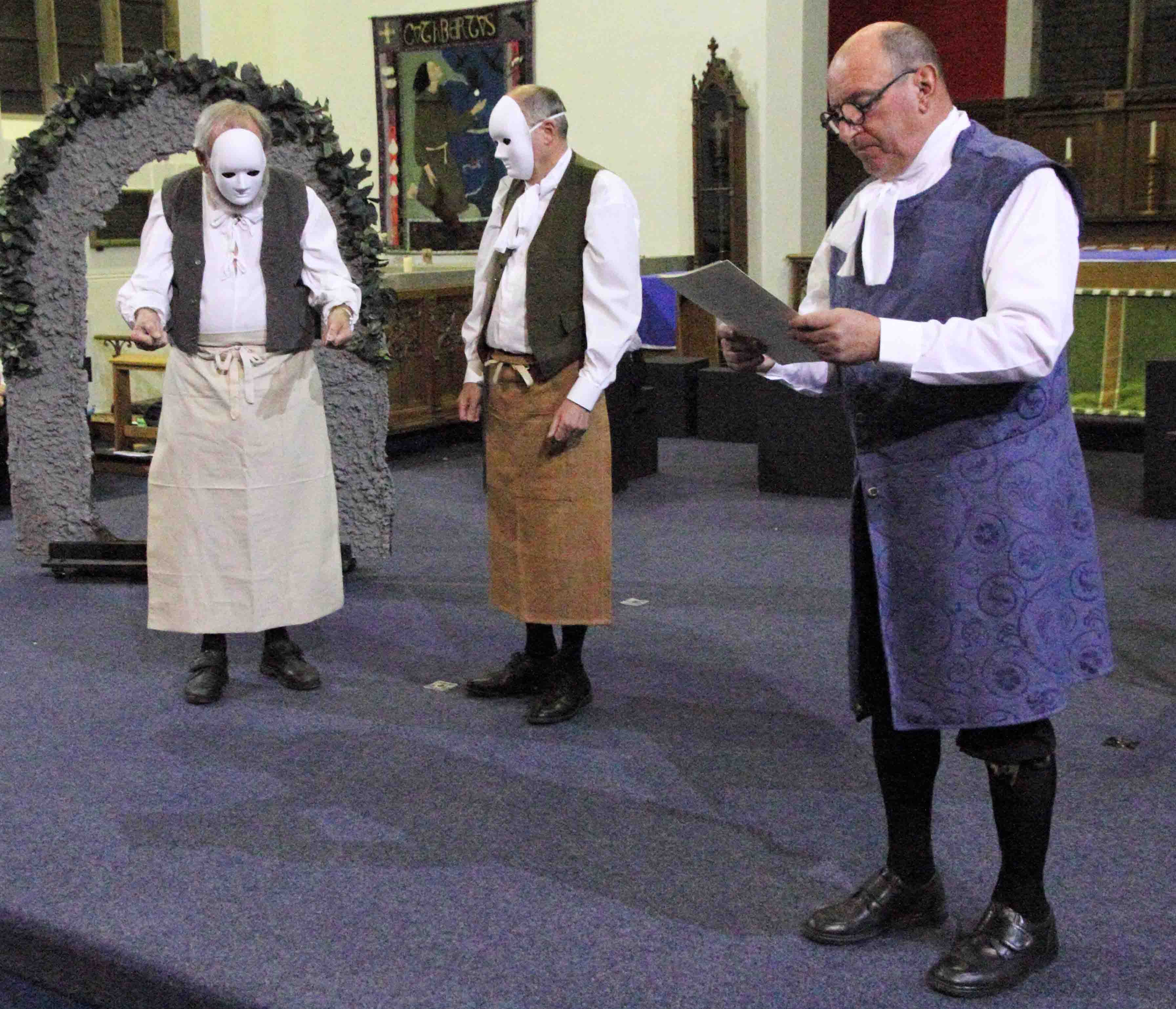
The Mime
The only character in the whole play not to be based on a real character was next on the stage: Rachel Joynson played the colourful fast-talking Bridget O’Reilly with Irish panache, pinpointing to Aram’s current location in King’s Lynn. Meanwhile the slow thinking Richard Houseman was interrogated by the Prosecutor and the Coroner and taken to York Prison where the Coroner declared a verdict of ‘Murder of a person unknown by person or persons unknown’. Richard Houseman suddenly changed his testimony considerably, implicating Eugene Aram and led the court to the second set of bones in St. Robert’s Cave.
Taken back to Yorkshire, Eugene Aram, faced the unpleasant William Noel, Justice of the Peace (Keith Burton) and his self effacing but efficient clerk played by Steve Boast.
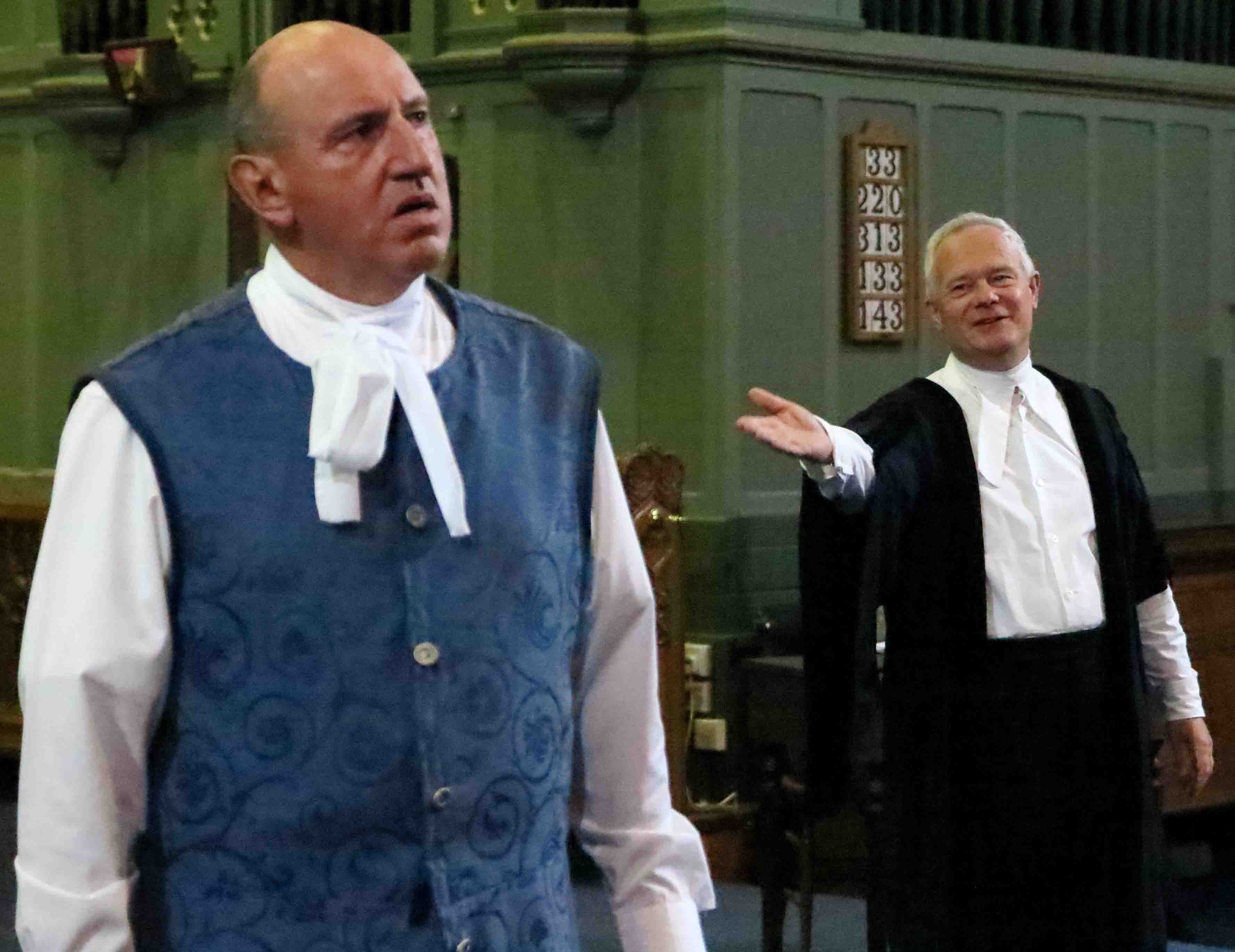
Keith Burton as Judge William Noel conducts the Trial
On being taken to York Castle prison Aram gave his testimony of the events surrounding Daniel Clark’s disappearance in the second of the atmospheric masked mimes, implicating Henry Terry the ale-house keeper as well as Richard Houseman. He was kept in the noisome conditions of York prison for a year, maintaining his sanity by continuing his research into languages.
During the York Assizes Aram, Terry and Houseman were eventually tried in front of a jury alongside other colourful felons: Jane Lister (Linda Harvey) and George Mason (Alan Young, excellent in his fourth role).
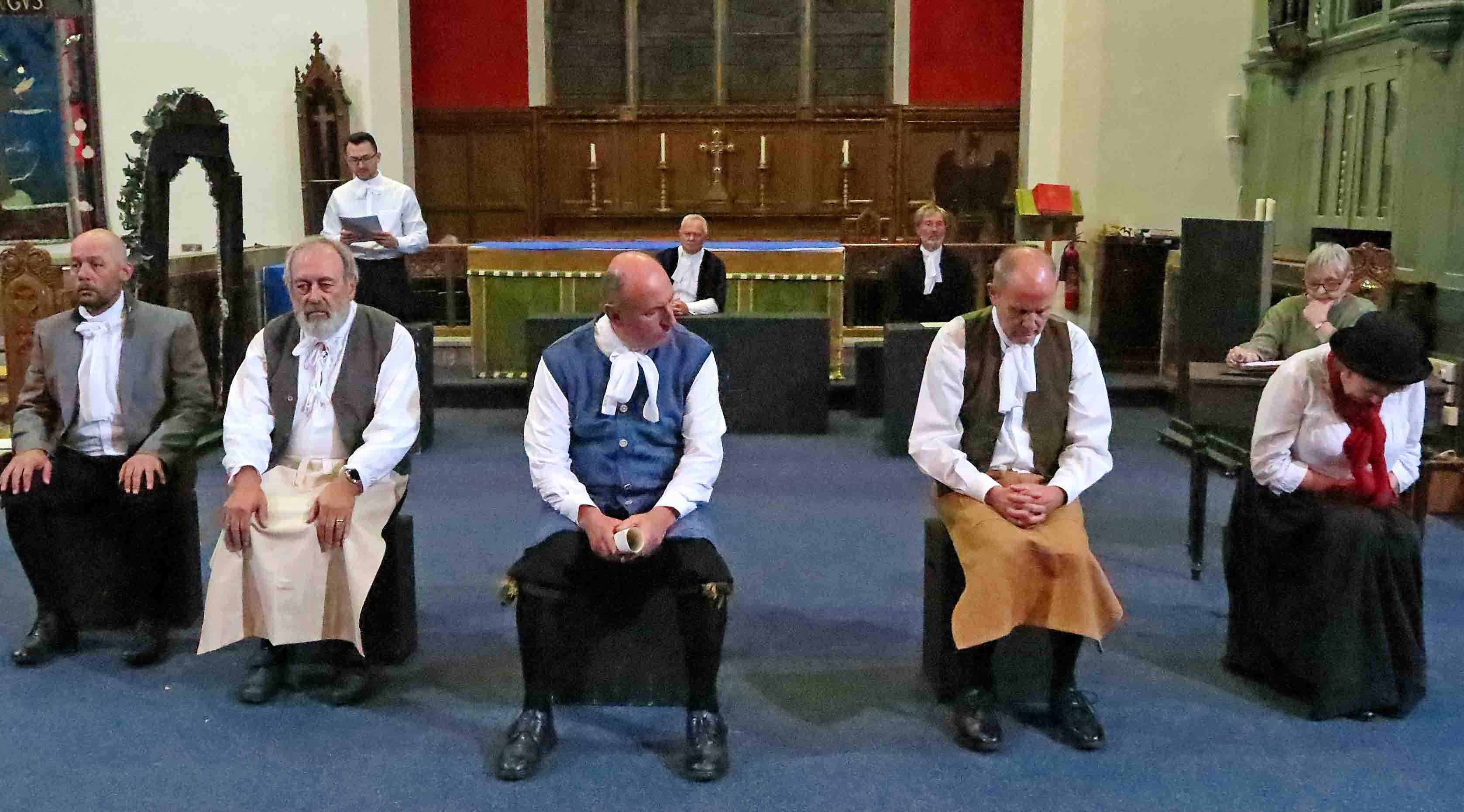
The Trial
The ineffectual Prosecutor had no evidence for either Henry Terry or Richard Houseman so these two were discharged. However he was able to call upon Richard Houseman whose testimony (in masked mime), in spite of Aram’s vigorous and logical defence and many positive testimonials from the people of Lynn, led the jury to bring in a verdict of “Guilty”. What a travesty! Such was the standard of justice in the eighteenth century. Three days after his sentencing Eugene Aram was taken to the Knavesmire to be executed.
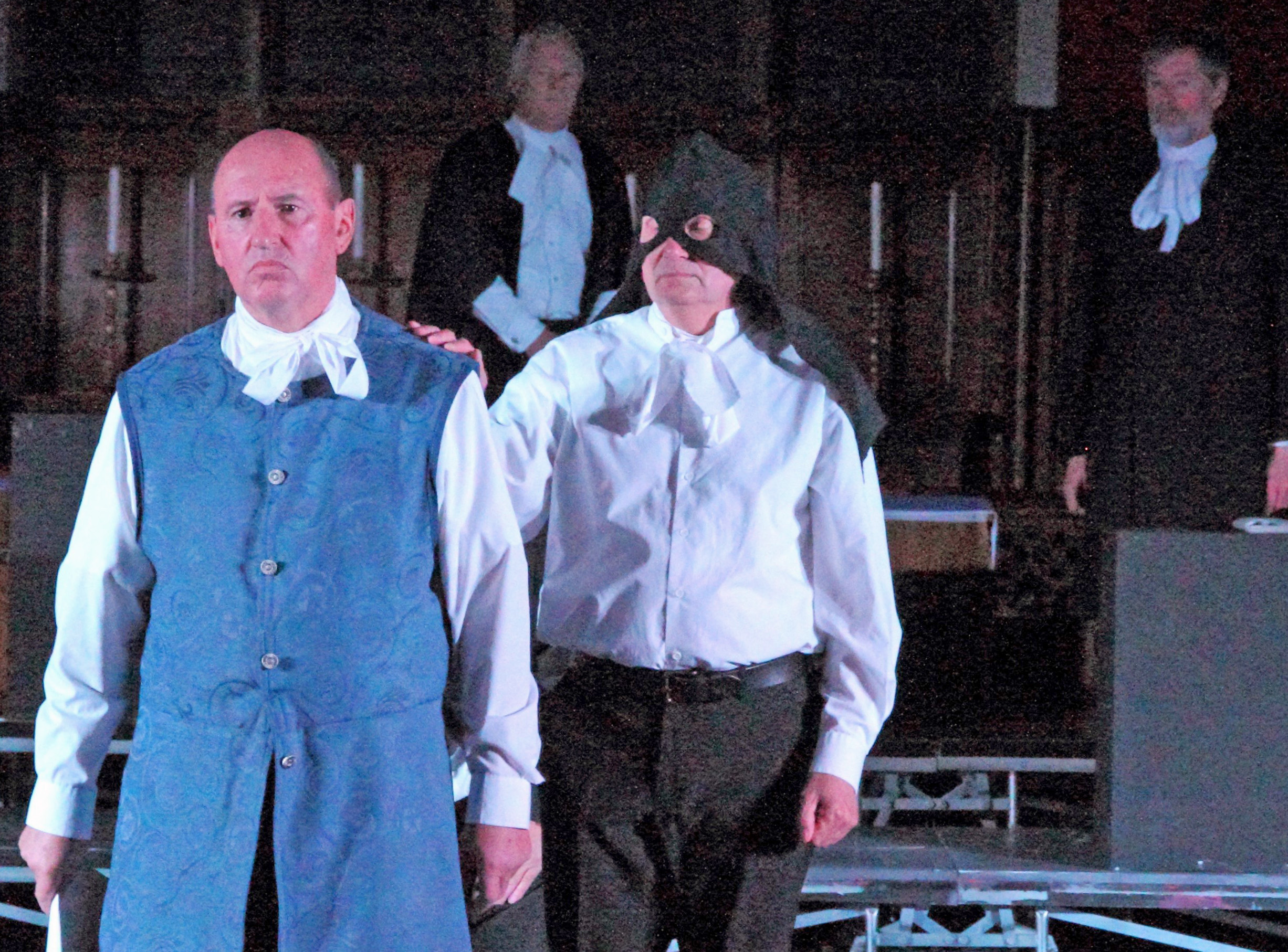
Eugene Aram is condemned
Throughout all this Tim Wilkinson, playing Eugene Aram, maintained an air of calm, resignation and detachment. His solo musings were heart wrenchingly beautiful, but there was no last-minute reprieve and we heard an echo of the ‘Prickle -Eye Bush’ before the Executioner pulled the trap door and Aram fell.
A verse had been found on a piece of paper in Aram’s cell after he had been taken for execution; the play ended with a poignant arrangement of these words by Nevin Ward based on a beautiful melody by Sibelius. First Aram spoke his own words, then the whole company filled the space with wonderful harmony- a truly moving ending.
The lights dimmed, there was a moment of intense silence and then the audience erupted into prolonged heart-felt applause.
What a triumph! The play was long, the seats became uncomfortable but the audience was completely absorbed as the story unfolded. Congratulations to Nevin and his wonderful team. It was a most beautiful and poignant swan song for a master playwright.
.jpg)
Nevin Ward, playwright and director
Review by Andrea Ives.
Photographs by Chris Iredale, Ruth Dodsworth, Jenny MacNair